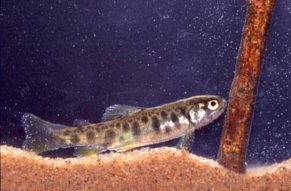|
Relationship Between Invertebrates and Stream Order: Implications for
Fish Distribution
Reagan Sutherland, University of New Brunswick Department of Biology
(email: b561a@unb.ca)
According to the River Continuum Concept (RCC), invertebrate community
structure changes in a predictable fashion from small headwater tributaries
to larger mainstem streams, due to hydrological influences, riparian
influences and nutrient flow. In the headwaters, streams are small,
and terrestrial inputs from surrounding vegetation are the primary sources
of energy (food). Primary production by aquatic plants is minimal due
to stream shading by surrounding vegetation. As the size of the stream
increases, in-stream primary production also increases and there is
less influence from the surrounding vegetation. This change in food
sources reflects changes in invertebrate and fish communities. Several
studies have tested the predictions of the RCC on community structure,
however few have examined secondary production in relation to stream
size or have linked invertebrate production to fish distribution. This
leads to the question: do fish distribution patterns reflect food (invertebrate)
availability? The objective of this study is to quantify the biotic
diversity found in streams of different orders in Fundy National Park
(FNP), New Brunswick, Canada. Predictions are twofold: 1. invertebrate
abundance decreases with increasing stream order (size) and 2. biomass
of brook trout (most common fish species) is directly related to invertebrate
abundance. Four sites on each of two rivers were chosen, representing
1st(smallest), 2nd, 3rd and 4th(largest) order streams. Aquatic invertebrate
abundance and brook trout density were determined at each site over
three seasons. Preliminary results show that invertebrate abundance,
trout biomass, and trout density were higher in small order streams.
These results provide evidence for the inverse relationship between
biotic abundance and stream size. The markedly low trout biomass in
larger streams in Fundy Park may be due to warm water temperatures (>20
C) and/or biological constraints (e.g. food availability).

Young brook trout
Click
to Return to the Main Page
|



